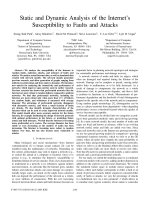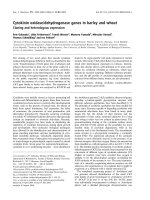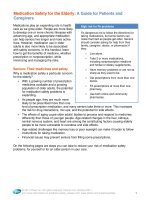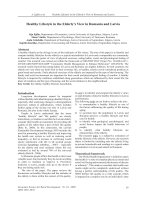Healthy Lifestyle in the Elderly’s View in Romania and Latvia docx
Bạn đang xem bản rút gọn của tài liệu. Xem và tải ngay bản đầy đủ của tài liệu tại đây (317.24 KB, 6 trang )
97
Economic Science for Rural Development Nr. 19., 2009
ISSN 1691-3078
Healthy Lifestyle in the Elderly’s View in Romania and Latvia
Aija Eglīte, Department of Economics, Latvia University of Agriculture, Jelgava, Latvia
Mona Vintila, Department of Psychology, West University of Timisoara, Romania
Anda Grīnfelde, Department of Sociology, Latvia University of Agriculture, Jelgava, Latvia
Ingrīda Kantiķe, Department of Accounting and Finances, Latvia University of Agriculture, Jelgava, Latvia
Abstract
A healthy lifestyle at the old age is one of the indicators of life values. The aim of the paper is to identify and
compare healthy lifestyles for the elderly in a typical microdistrict in Latvia and a comparable size community
in Romania from the points of view of physical exercises, eating habits, social and physiological feeling of
comfort. The research was carried out within the framework of GRUNDTVIGT Project No. 134240-LLP-1-
207-DE-GRUNDTVIGT-GMP “Community Health Management to Enhance Behaviour” (CHANCE). The
research results showed that eating habits in Latvia and Romania are slightly different. In both countries, the
elderly not very often use fresh food in their everyday life, or healthy, relative newly introduced products as
grain bread and cereals. Daily physical exercises of the elderly are impacted by the type of their housing. The
family and social environment are important for their social and physiological feeling of comfort. A healthy
lifestyle is impacted by traditions established along generations which are inuenced by their social life, the
place of residence and the type of housing, and the social relations in the neighbourhood.
Key words: the elderly, healthy lifestyle, households.
Introduction
Long-term development cannot be imagined
without healthy individuals keeping a healthy lifestyle,
especially after analysing changes in demographical
processes related to globalisation, which includes
further aging of the society not only in Latvia and
Romania, but also in the whole Europe.
People in Latvia understand that the terms
“healthy lifestyle” and “life quality” are closely
interrelated, yet studies reveal that the Latvian elderly
consider their health an instrument for providing the
quality of life rather than a part of their life quality
(Bela B., 2006). In this connection, the Latvian
Sustainable Development Strategy 2030 includes the
need for promoting a healthy lifestyle and improving
the health care system as well as reducing social
inequality, so that an increase in well-being would
ensure satisfaction with life in all societal groups
(Latvijas ilgtspējīgas attīstības , 2007) – especially
for the elderly and rural residents whose life was
evaluated as bad by around 70% of the surveyed
elderly (Bela B., 2006).
In Romania people affirm that health is their most
valuable asset, but practically they do not do anything
in order to maintain or improve it. Preventive
medicine is scarce, people only go to the doctor if
they are feeling really sick.
The aim of the paper. The paper reviews the
discussions on healthy lifestyles and the attitudes of
the elderly to them within the context of life quality.
Its aim is to identify and compare the elderly’s views
on and attitudes related to healthy lifestyles in Latvia
and Romania.
The following tasks are set forth to achieve the aim:
to conceptualise a healthy lifestyle as one of 1)
the factors inuencing the quality of life during
aging;
to ascertain how the population in Latvia and 2)
Romania perceive a healthy lifestyle and their
care for health;
to identify what geological, psychological, and 3)
social factors impact the health behaviour of
people;
to identify what healthy lifestyles are 4)
characteristic of the elderly.
The research topic is a subjective evaluation of
healthy lifestyle of the elderly. However, the research
object is limited by including only the elderly living
in private households and residing in a typical urban
microdistrict in Latvia and suburb in Romania.
Theoretical framework
The World Health Organisation’s definition states
that health is “a state of complete physical, mental and
social well-being and not merely the absence of disease
or infirmity”. This made us conclude that health care
results might not be completely understood without
having a perfect understanding of life quality. The
WHO defines life quality as a wide concept, which
is impacted in a complex way by an individual’s state
A. Eglīte et al. Healthy Lifestyle in the Elderly’s View in Romania and Latvia
98
Economic Science for Rural Development Nr. 19, 2009
ISSN 1691-3078
of health, psychological state, beliefs, relations with
other people and the most significant environmental
factors (Smith A., 2000).
Both care and carelessness for one’s own health
is a result of interaction among psychological,
physical, and social factors. Ann Bowling calls it the
biopsychosocial health model or “health lifestyle”.
A health lifestyle is “intentional health behaviours
based on the alternatives available in each particular
situation” (Bowling A., 2002).
Health behaviour is:
an activity carried out by a person considering 1)
himself / herself healthy in order to prevent a
disease;
activities that are carried out irrespective 2)
of the state of health in order to prevent
diseases;
any behaviour performed by a person with the 3)
purpose to protect, promote, or preserve his/her
health irrespective of an understanding of his/her
state of health;
an activity for reducing the risk of getting ill, 4)
and a behaviour having as purpose to promote
health.
The care for health is a general notion of one’s
health as a measure of values that ensures sufficient
life quality, a sufficiently long life, and a good
physical feeling.
The care for health is exposed as a holistic
lifestyle (system of health habits), in which health is
included in the basic values of life and in the concept
of life quality. Knowledge on the constitution and
functions of one’s own organism and delivery of
information on available health care services allow
people to adequately act in case of illness (system
of disease habits).
Therefore the health behaviour determines three
types of categories:
Individual categories.1.
Social and cultural categories.2.
Capability categories.3.
What does it mean to care for health? Does
it mean preventing diseases and abstaining
from unhealthy habits or trying to maintain the
functionality of the body and mind given by nature;
not only maintaining, but also promoting one’s
own health?
Research methods. The research in this paper
is focused on sociological surveys in the form of
interviews and on data processing using statistical
research methods. The research is unique due
to the fact that it was carried out in two new EU
member states simultaneously. A typical part of a
town, specific to each country, was chosen for the
research object. The research subject in this paper is
the elderly.
Research results
RAF microdistrict in the city of Jelgava acquired
its name from Riga Autobus (minibus) Factory which
was located in Jelgava. Dwelling houses were built
for the factory’s employees in the vicinity of the
factory. The microdistrict is situated in the North
East of Jelgava, on the right bank of the river Lielupe,
around 3 km away from the centre of Jelgava towards
the capital city of Riga. As of January 1, 2008, 4520
residents lived in the microdisctrict’s territory which
was chosen for the research. The average size of
households in RAF is 2.89. Natural gas and electric
power is supplied to RAF microdistrict; it has a
centralised water supply system and a sewage system
which is connected to the city’s water treatment plant.
A block in the RAF microdistrict consists of five-
storey and nine-storey dwelling houses which were
built in the 1970s. The chosen territory has a school
with a pool, a sports hall and a sports ground, which
is available also to the microdistrict’s residents, 2
kindergartens, 4 small food stores, a baker’s store, a
household goods store and 3 shopping centres, a café
and a fast food restaurant, a post office, 2 drugstores,
a dentist’s office, a doctor’s office, a library, 3
gambling halls, 3 playgrounds for children, a dry
cleaning shop and a laundry, a footwear repair shop,
a petrol and gas station, and a car repair shop. There
is a forest just across Loka Magistrale Street, which
is a favourite resting place for Jelgava residents. Next
to the forest, there is a guarded complex of private
garages, a tombstone shop, and Bērzi cemetery. Since
the RAF microdistrict was build during the Soviet
times, no church is available.
Dumbravita is a suburb of Timisoara, which has
developed from a small village during the first 20
years, becoming a suburb of Timisoara. It has 2915
inhabitants and 1417 households. The average size
of households in Dumbravita is 2.06. There is a
school, 1 kindergarten; there are several churches and
a relatively large forest – 648 ha. 27 teachers work
in Dumbravita and 2 doctors. There are very few
unemployed people out of those of working age. A
little more than half of the population is represented by
the females – 52.63% and the rest by the males. There
are Romanians, Hungarians and German nationality
inhabitants, mainly Orthodox and Catholics.
Empirical information was simultaneously gained
during May-June 2008 while conducting a quantitative
survey of communities in the RAF microdistrict in
Jelgava and in Dumbraviat a suburb of the town of
Timisoara. The total number of respondents was 255 in
Jelgava, of whom 44 were at the age of 61 and older (8
males) – 26 Latvians and 18 Russians. In Dumbravita
200 individuals were questioned, of whom 90 were
at the age of 61 and older. In Jelgava the elderly live
as singles (43%) or together with a partner or a child
A. Eglīte et al. Healthy Lifestyle in the Elderly’s View in Romania and Latvia
99
Economic Science for Rural Development Nr. 19., 2009
ISSN 1691-3078
(39%), the rest of them – in households of several
individuals. In Timisoara the majority of the elderly
live in couples, the size of other households is about
the same, but the proportion of the single elderly is
only 13% (Figure 1).
The elderly in Romania evaluate their material
position, as compared with the residents living in
their community, as equivalent, but some of them - as
above the average. In Latvia the elderly evaluate their
material position as the same or worse, but no one
evaluates it as better than that of his/her neighbours.
The Romanian elderly evaluate their material position
as slightly better, as compared with their community
residents, than it is in Latvia.
Both the elderly in Dumbravita and those in
Jelgava feel well in their homes, and they like
their apartments or houses. In Jelgava 73% of the
elderly are the owners of their apartments, while in
Dumbravita – 97%. In both countries the proportion
of apartment owners among the elderly is slightly
above the average indicator.
In Jelgava the size of apartments is less than 60m
2
in
most cases, whereas in Timisoara it is more than 100
m
2
(Figure 2).
The elderly try to cope with their household work
themselves. Almost two thirds of the Latvian elderly
believe that they need no help in their household
work, but 25% of them need it in cleaning up their
Figure 1. Number of individuals in the households of the elderly in Latvia and Romania
Figure 2. Size of the homes of the elderly in Jelgava and Dumbravita
A. Eglīte et al. Healthy Lifestyle in the Elderly’s View in Romania and Latvia
100
Economic Science for Rural Development Nr. 19, 2009
ISSN 1691-3078
apartments. The Romanian elderly need help only for
shopping, cleaning up their apartments, and filling in
documents.
55% of the elderly in Latvia and respectively 51%
in Romania believe that they are well informed about
a healthy lifestyle from the points of view of physical
exercises, healthy food, and social and psychological
feeling of comfort. 41% of the Romanian elderly and
23% of the Latvian elderly said they were partially
informed about a healthy lifestyle from the point of
view of physical exercises. The Latvian elderly feel
to be better informed than the Romanian elderly about
physical exercises. 78% of the Romanian elderly and
61% of the Jelgava elderly are well informed about
healthy food, while 16% of the Latvian elderly and
only 1% of the Romanian elderly feel uninformed.
The Romanian elderly also feel to be better informed
about the social and mental feeling of comfort as an
element of healthy lifestyle.
The majority of the elderly in both countries does not
believe that keeping a healthy lifestyle is boring.
In Latvia the elderly get information about
healthy lifestyles mostly from TV, followed by a
doctor and friends, whereas in Romania the main
source of information about healthy lifestyles is
a doctor, followed by TV and the family. For the
Latvian elderly, the family as a source of information
takes the fifth position after neighbours. It might be
explained by the fact that the Latvian elderly live
mostly as singles, but the Romanian elderly mostly
live in families.
Therefore if the Latvian elderly have problems,
they mostly try to handle them themselves (57%) as
compared with the Romanian elderly – 45% of them
do the same. But the Romanian elderly do not put their
problems on others because they have not chosen as
option that they do not solve their problems.
If there are health, food, or movement problems,
the Romanian elderly ask a doctor first and then try to
solve them in the family, whereas in Latvia it is vice
versa – they try to solve their problems by the help of
the family and only after they go to see a doctor.
The largest part of the elderly spends more than
three hours outside their homes. It, of course, depends
on the age and health condition. But there are different
opinions about doing physical exercises. The largest
part of the Romanian elderly believe they do physical
exercises for more than 5 hours a week, but almost
a third of the elderly from the RAF microdistrict
believe they do not do physical exercises at all. It
could be explained by the form of inhabitation, the
type of home, and national traditions. In Latvia, TV is
watched for a longer time than in Romania.
For the RAF elderly, the five most important
establishments of infrastructure are the market place,
health service, recreational area, food stores, and
social care. The elderly from Dumbravita place the
church in the first position, followed by the health
service, recreational area, school, kindergarten, but
the least important are the sports clubs, social centres,
and educational service. The sports clubs, pool,
sports ground and sports hall as well as educational
institutions, kindergarten and school are the least
important for the RAF elderly, too.
The elderly in both countries have similar eating
habits when consuming milk, sweets, cakes, cereals,
wine, beer, and lemonade. More than 50% of the
surveyed consume milk everyday, and 85% at least
once a week. More than half of them consume sweets
at least once a week. The elderly of both countries do
Figure 3. I read the information on packages about the ingredients and energy value of food products
A. Eglīte et al. Healthy Lifestyle in the Elderly’s View in Romania and Latvia
101
Economic Science for Rural Development Nr. 19., 2009
ISSN 1691-3078
not consume cereals, lemonades, wine, and beer as
daily foods. The elderly in Latvia more often drink
tea, whereas in Romania – drinking water. In Latvia
there are slightly more elderly who consume vitamins
everyday, but in both countries more than half of the
elderly use vitamins very rarely or never.
The Romanian elderly consume more margarine
everyday, but the Latvian elderly prefer butter.
The Latvian elderly consume more vegetable oil
everyday than the Romanian elderly. Fish is included
in the diet of the Romanians more often than in that
of the Latvians. Yet the Latvians eat more cheese
as compared with the Romanians. The Romanians
more often consume fruit and vegetables, but the
Latvians eat potatoes even several times a day.
Rice and macaroni are more often consumed by the
Romanians. Grain bread is consumed everyday by
25% of the Jelgava elderly, but the Romanians eat it
very rarely. The Romanians used to eat wheat bread
almost at each mealtime. In Latvia wheat bread is
more favourite among those who speak Russian at
home; the Latvians eat rye bread more often than the
Russians.
86% of the respondents in Latvia cook food at
home themselves, in Romania respectively 64%. In
Romania 58% of the elderly go shopping themselves,
while 75% do it in Latvia. Both the Romanian
and Latvian elderly, when buying food products,
sometimes read the information on product packages,
but 16% of the respondents do it always. The
Romanians more often spend their money on healthy
food than the Latvians.
The largest part of the elderly believes that their
health is very important or important, but about half
of the elderly in both countries regard their health
as good or very good. Yet in Latvia the elderly have
more rarely assessed their health as very good. Half
of them believe their health will not change over the
further three years. However, the second half of the
Latvian elderly are more pessimistic compared with
the Romanians. The elderly in both countries are not
very interested in active sports, but if they were the
leaders of their microdistricts, they would construct
recreational and sports grounds and a green zone
restore a health trail in the forest, repair sidewalks,
install benches, make flowerbeds, organise various
activities for the elderly, for instance, gymnastics
exercises, tea evenings, or dancing.
Conclusions
The opinions of the elderly proved that a healthy
lifestyle include not only healthy food, physical
exercises, but also a social and psychological feeling
of comfort. A feeling of comfort is important to the
elderly living in multi-apartment houses not only in
their apartments, but also in the backyards, stairways,
on the street or sidewalk as well as in the nearest
vicinity.
It is specific in Timisoara that the elderly spend
more their time outdoors, therefore less time is spent
watching TV.
In Latvia the first adviser in health care is the
family, followed by a doctor; in Romania it is vice
versa. It could be explained by the availability of
health care in each country.
There are different eating traditions in Latvia
and Romania. A healthy lifestyle is impacted by the
traditions established by generations in their social
life, the place of residence and the type of housing,
and the social relations in the neighbourhood.
Figure 4. Wheat bread consumption frequency for the elderly in Latvia and Romania
A. Eglīte et al. Healthy Lifestyle in the Elderly’s View in Romania and Latvia
102
Economic Science for Rural Development Nr. 19, 2009
ISSN 1691-3078
The elderly have stable eating habits that have
formed over their life, therefore they relatively
rarely use “new” products like cereals and grain
bread.
Bibliography
1. Bela B. Dzīves kvalitāte Latvijā. Latvijas Valsts
prezidenta kanceleja.2006
2. Bowling A. Research Methods in
Health: Investigating Health and
Health Services. Philadelphia, 2002.
p. 33
3. CHANCE community-health.eu (Community
Health Management to Enhance Behaviour)
[skatīts 2009.gada 21. janvārī] Available at:
/>4. Latvijas ilgtspējīgas attīstības stratēģija līdz
2030.gadam. Pamatziņojums. Oktobris, 2007
5. Smith A., Researching quality of life of older
people: concepts, measures and ndings. Centre
for Social Gerontology, School of Social Relations
Keele University, Working Paper No. 7, November,
2000 [skatīts 2007.gada 26.augustā] Available at:
/>research_quality.pdf )
A. Eglīte et al. Healthy Lifestyle in the Elderly’s View in Romania and Latvia









